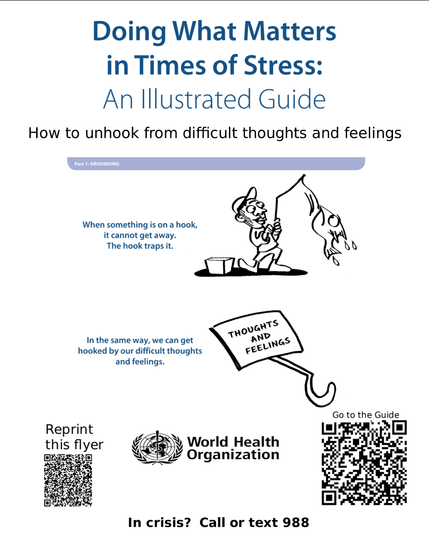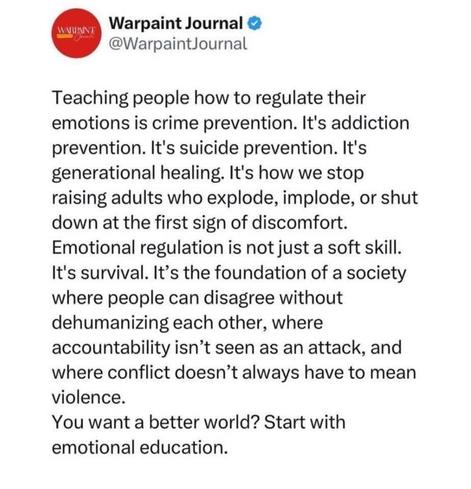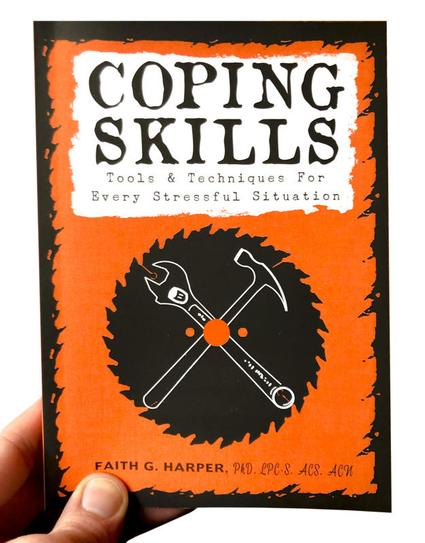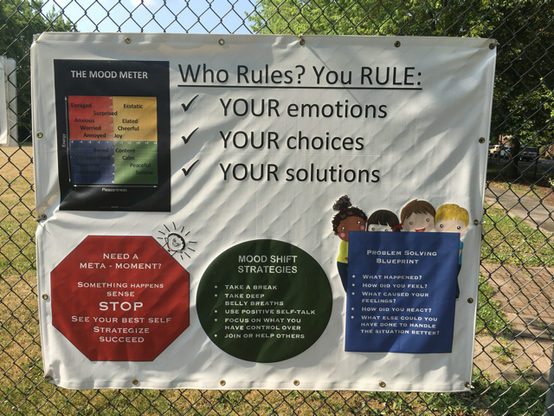@raindrops_and_roses @BlakeHamiltonCA
...it use to be...🤷♀️
@dexter @raindrops_and_roses @VeroniqueB99 @BlakeHamiltonCA
That is literally why we have music in schools
@Toasterson @VeroniqueB99 @raindrops_and_roses @BlakeHamiltonCA
I was never taught any of this, either. My first exposure was reading parenting books - "Parenting from the Inside Out" was a big eye-opener for me. It would be useful even for a non-parent, as it focuses on how we develop, and how things have a funny way of lingering from one generation to the next (and how to recognize and stop it!)
@Toasterson @raindrops_and_roses @BlakeHamiltonCA
To teach them what?
@Toasterson @raindrops_and_roses @BlakeHamiltonCA
Oh no no sorry I misunderstood you. I can't think of books other than psych books but this is something parents teach (or should teach) kids...
@Toasterson @raindrops_and_roses @BlakeHamiltonCA
Anything with "emotional regulation" (so early childhood) ...
@silk_flame @Toasterson @raindrops_and_roses @BlakeHamiltonCA
yeah... that's where the problem lies... (GenX here too I hear ya 🤣)
@Toasterson @VeroniqueB99 @raindrops_and_roses @BlakeHamiltonCA
If you don't mind profanity, I found Faith Harper's book, Coping Skills, to be a good resource. Her style isn't for everyone though
@VeroniqueB99 @raindrops_and_roses @BlakeHamiltonCA Bring back “home economics”! Nobody knows how to cook, balance a checkbook, or do basic home repairs.
When a labor force or population cannot perform basic self-care tasks, they are significantly more vulnerable to the “company store” abuse scam that the billionaires are forcing on everyone. The plan is for this to be the whole US. Isolating the US, as with tariffs that serve no other purpose, is step 1.
CrazyDogLady —
I definitely agree we need to teach more life skills—but let’s not romanticize “home ec” as it was, shall we? It was often quite sexist, outdated, and unequipped for today’s realities. What we need is a modern, inclusive life skills curriculum: financial literacy, cooking, digital as well as physical hygiene, critical thinking, and yes—basic repairs too.
@heartofcoyote @VeroniqueB99 @raindrops_and_roses @BlakeHamiltonCA
Who balances an actual checkbook these days? The "Family Consumer Sciences" (formerly home economics) that I had to take taught me how to set a fancy dining table for American and English standards, made me sew a pair of pajamas that I couldn't wear because the only pattern we were allowed to use was not made for those with a big booty, and how to measure flour. None of this was useful.
And I got in trouble for using the sewing machine at a reasonable speed. They were terrified we would sew through our fingers so we had to slow down to a snails pace.
Emotional regulation was not taught in this class at all
@raindrops_and_roses @BlakeHamiltonCA @VeroniqueB99
I mean, if you dig down a bit "sticks and stone my break my bones but words can never hurt me" touches on learning to control one's emotional response to verbal bullying.
But that only touches on the verbal part of things.
Yes, well explained!
Duh! I've spent my whole life teaching myself how, but now I will die without it having any positive impact.
The limbic brain is now a noose around humanity's neck. We won't advance on the Kardashev scale while that noose remains.
A lot of this is taught and reinforced through communities, which have also been getting ripped apart by capitalism in the name of monetizing interaction.
Social media seems to make things worse.
Poster from a schoolyard near me —
The small print is in some response posts not in my alt text; thank you to:
https://mstdn.ca/@BlakeHamiltonCA/114626175951260225
https://fe.disroot.org/objects/501407d9-a27d-4428-b63e-955958b44907
@clew
[1/2]
1) Top left: A graphic labeled “The Mood Meter” shows a 4-color quadrant of emotions—red (angry/tense), yellow (excited/ecstatic), green (calm/peaceful), and blue (sad/tired)—to help identify feelings.
2) Top right (main title):
Who Rules? You RULE:
✓ YOUR emotions
✓ YOUR choices
✓ YOUR solutions
3) Bottom left (red octagon):
Need a META-MOMENT?
Something happens
Sense
STOP
See your best self
Strategize
Succeed
@clew
[2/2]
4) Bottom center (green circle):
Mood Shift Strategies
• Take a break
• Take deep belly breaths
• Use positive self-talk
• Focus on what you have control over
• Join or help others
5) Bottom right (blue square with cartoon children):
Problem Solving Blueprint
• What happened?
• How did you feel?
• What caused your feeling?
• How did you react?
• What else could you have done to handle the situation better?
@clew @BlakeHamiltonCA Top-left corner - a navy rectangle labelled “The Mood Meter”. It contains a graph with “Pleasantness” along the X axis and “Energy” along the Y axis.
The top-left quadrant (high energy, low pleasantness) is colored red, and contains (with increasing pleasantness) Enraged, Anxious, Worried, and Annoyed.
The top-right quadrant (high energy, high pleasantness) is colored yellow, and contains (with increasing pleasantness) Joy, Cheerful, Elated, and Ecstatic.
Surprised is written somewhere between the red and yellow quadrants, leaning towards red.
The bottom-left quadrant (low energy, low pleasantness) is colored blue, and contains (with increasing pleasantness) Depressed, Hopeless, Disappointed, and Bored.
The bottom-right quadrant (low energy, high pleasantness) is colored green, and contains (with increasing pleasantness) Content, Calm, Peaceful, and Serene.
Bottom-left corner - a red octagon resembling a traffic stop sign. There’s a joyful child jumping out of its top-right edge. The sign says, in white lettering -
“Need a
meta-moment?
Something happens
Sense
STOP
See your best self
Strategize
Succeed”
Bottom-center - a green circle with white letters, labelled “MOOD SHIFT STRATEGIES” -
- Take a break
- Take deep belly breaths
- Use positive self-talk
- Focus on what you have control over
- Join or help others
Bottom-right corner - a blue rectangle with white letters. There are happy colorful illustrations of two girls and two boys behind it. It is labelled “Problem Solving Blueprint” -
- What happened?
- How did you feel?
- What caused your feelings?
- How did you react?
- What else could you have done to handle the situation better?
The top-left Mood Meter has axes labeled "energy" and "pleasantness"; the Moods are enraged, surprised, anxious, worried, annoyed, ecstatic, elated, cheerful, joy, bored, disappointed, hopeless, depressed, content, calm, peaceful, and serene.
The bottom left octagon says:
"Need a meta-moment?
Something happens
Sense
Stop
See your best self
Strategize
Succeed"
The bottom middle circle says:
"Mood shift strategies
- Take a break
- Take deep belly breaths
- Use positive self-talk
- Focus on what you have control over
- Join or help others"
The bottom right square says:
"Problem solving blueprint
- What happened?
- How did you feel?
- What caused your feelings?
- How did you react?
- What else could you have done to handle the situation better?"
WHO has a good free guide to help with that: https://m.ai6yr.org/@knowattitude/111313426911650860

KnowAttitude (@knowattitude@m.ai6yr.org)
Attached: 2 images The first link is to a PDF flyer with a QR code for WHO's "Doing What Matters in Times of Stress: An Illustrated Guide" (How to unhook from difficult thoughts and feelings), in case anyone would want to print some out and staple them to a local kiosk. There is a new line at the bottom directing anyone in crisis to call or text 988. #MentalHealth https://drive.google.com/file/d/1jofXFw0FUaKTZukbjQt4FZ_Mnu9h_z81/view?usp=drive_link El primer enlace lleva a un folleto en PDF con un código QR para la guía ilustrada de la OMS "Hacer lo que importa en tiempos de estrés" (Cómo liberarse de pensamientos y sentimientos difíciles), por si alguien quiere imprimirlo y graparlo en un quiosco local. Hay una nueva línea al final que indica a cualquier persona en crisis que llame o envíe un mensaje de texto al 988. #SaludMental https://drive.google.com/file/d/16LG5FwT7scgSYcXSP4_QPwRXHUTn6oAK/view?usp=drive_link This second link is direct to the World Health Organization download page for the 132-page graphic book and audio files in English. Español and many other languages are available. https://www.who.int/publications/i/item/9789240003927 Este segundo enlace lleva directamente al Organización Mundial de la Salud, a la página de descarga del libro gráfico de 132 páginas y los archivos de audio en español. Hay muchos otros idiomas disponibles. https://iris.who.int/bitstream/handle/10665/336218/9789240009561-spa.pdf
Watching Mr. Rogers as an adult I was shocked at how focused he was on this.
It's a shame it didn't stick, because all I remembered was how much I wanted that trolley and how much I hated the ugly puppet who lived in the carousel.
@BlakeHamiltonCA I recommend reading Nonviolent Communication by Marshall Rosenberg to everyone. It changed my life.
"All violence is the result of people tricking themselves into believing that their pain derives from other people and that consequently those people deserve to be punished."
Also would like free tuition for this kind of education. Pleading for humanity's sake. 🙏



